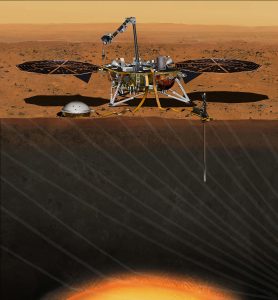By Steve Gorman
LOS ANGELES (Reuters) – NASA’s first spacecraft built to explore the deep interior of another world streaked toward a landing scheduled for Monday on a vast, barren plain on Mars, carrying instruments to detect planetary heat and seismic rumblings never measured anywhere but Earth.
After sailing 301 million miles (548 million km) on a six-month voyage through deep space, the robotic lander InSight was due to touch down on the dusty, rock-strewn surface of the Red Planet at about 3 p.m. EST (2000 GMT).
If all goes according to plan, InSight will hurtle through the top of the thin Martian atmosphere at 12,000 miles per hour (19,310 kilometers per hour). Slowed by friction, deployment of a giant parachute and retro rockets, InSight will descend 77 miles through pink Martian skies to the surface in 6 1/2 minutes, traveling a mere 5 mph (8 kph) by the time it lands.
The stationary probe, launched in May from California, will then pause for 16 minutes for the dust to settle, literally, around its landing site, before disc-shaped solar panels are unfurled like wings to provide power to the spacecraft.
The mission control team at NASA’s Jet Propulsion Laboratory (JPL) near Los Angeles hopes to receive real-time confirmation of the craft’s arrival from data relayed by a pair of miniature satellites that were launched along with InSight and will be flying past Mars.
The JPL controllers also expect to receive a photograph of the probe’s new surroundings on the flat, smooth Martian plain close to the planet’s equator called the Elysium Planitia.

FILE PHOTO: The NASA Martian lander InSight dedicated to investigating the deep interior of Mars is seen in an undated artist’s rendering. NASA on Wednesday said it would fix the InSight lander that was grounded in December due to a leak in its primary science instrument, putting the mission back on track for another launch attempt in 2018. REUTERS/NASA/JPL-Caltech/Handout via Reuters
The site is roughly 373 miles (600 km) from the 2012 landing spot of the car-sized Mars rover Curiosity, the last spacecraft sent to the Red Planet by NASA.
The smaller, 880-pound (360 kg) InSight – its name is short for Interior Exploration Using Seismic Investigations, Geodesy and Heat Transport – marks the 21st U.S.-launched Mars missions, dating back to the Mariner fly-bys of the 1960s. Nearly two dozen other Mars missions have been sent from other nations.
InSight will spend 24 months – about one Martian year – using seismic monitoring and underground temperature readings to unlock mysteries about how Mars formed and, by extension, the origins of the Earth and other rocky planets of the inner solar system.
While Earth’s tectonics and other forces have erased most evidence of its early history, much of Mars – about one-third the size of Earth – is believed to have remained largely static, creating a geologic time machine for scientists.
InSight’s primary instrument is a French-built seismometer, designed to record the slightest vibrations from “marsquakes” and meteor impacts around the planet. The device, to be placed on the surface by the lander’s robot arm, is so sensitive it can measure a seismic wave just one half the radius of a hydrogen atom.
Scientists expect to see a dozen to 100 marsquakes during the mission, producing data to help them deduce the depth, density and composition of the planet’s core, the rocky mantle surrounding it, and the outermost layer, the crust.
The NASA Viking probes of the mid-1970s were equipped with seismometers, too, but they were bolted to the top of the landers, a design that proved largely ineffective.
Apollo missions to the moon brought seismometers to the lunar surface as well. But InSight is expected to yield the first meaningful data on planetary seismic tremors beyond Earth.
InSight also is fitted with a German-made drill to burrow as much as 16 feet (5 meters) underground, pulling behind it a rope-like thermal probe to measure heat flowing from inside the planet.
Meanwhile, a radio transmitter will send back signals tracking Mars’ subtle rotational wobble to reveal the size of the planet’s core and possibly whether it remains molten.
NASA officials say it will take two to three months for the main instruments to be deployed and put into operation.
(Reporting and writing by Steve Gorman in Los Angeles; Editing by Michael Perry)
 A full-scale replica of NASA's Mars InSight, a robotic stationary lander that marks the first spacecraft designed to study the deep interior of the Red Planet, or any distant world, is seen inside a large tent on the campus of NASA's Jet Propulsion Laboratory (JPL) in Pasadena, California, U.S., November 21, 2018. REUTERS/Steve Gorman
A full-scale replica of NASA's Mars InSight, a robotic stationary lander that marks the first spacecraft designed to study the deep interior of the Red Planet, or any distant world, is seen inside a large tent on the campus of NASA's Jet Propulsion Laboratory (JPL) in Pasadena, California, U.S., November 21, 2018. REUTERS/Steve Gorman
